New Rapid-Drying Concrete Addresses Floor Covering Failures
The Ideal Solution
The truth is that there is no company that offers a moisture mitigation system that has a perfect track record of success. When failure of a moisture mitigation system occurs, the cost of correction can be many times the original expense and may also cause the owner of the building to lose revenue. Repairing the repair is not a situation that anyone can afford.
The ideal solution to avoid slab-related moisture problems would be for the slab itself to dry naturally to the required level in an acceptable amount of time. Over the years a number of concrete experts have designed concrete mixtures that could dry quickly but these mixtures were difficult to place and finish and next to impossible to pump.
Today there is new promise that can help put an end to moisture-related flooring problems using concrete that consumes its free water internally and is easy to place, finish and pump. This new approach to rapid-dry concrete has taken years to develop and been validated both in laboratory and field conditions.
Rapid Drying Concrete
After more than six years of research, laboratory testing, and field verification, a new concrete solution has recently been developed that combines the benefit of rapid drying with placement and finishing characteristics similar to those for conventional concrete. Through a combination of unique chemistry and controlling the water of convenience the new portland cement-based concrete solution dries in a fraction of the time required by conventional concrete.
The significant advantage to this cost-effective concrete solution is its ability to stop slab moisture problems from the very beginning and avoid the many problems of moisture emission.
Equally significantly, it contributes to maintaining the health and safety of building occupants by addressing some of the root causes of damp building and illnesses
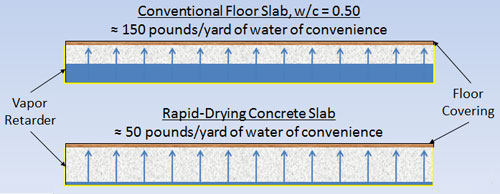 |
With less water of convenience compared with a conventional slab, a rapid-drying slab employing new technology dries more quickly. Image provided by U.S. Concrete |
The new mixture can be placed using conventional equipment, such as concrete pumps, and it can be finished using standard equipment, including laser screeds, conventional vibratory screeds, pan floats, and power trowels.
MVER and RH levels
Field and lab tests have demonstrated that target levels of internal relative humidity (RH) are reached 45 days after building enclosure. Under high internal relative humidity conditions some conventional concrete will never reach those levels.
The new mixture also quickly and permanently meets the moisture requirements for most types of flooring materials.
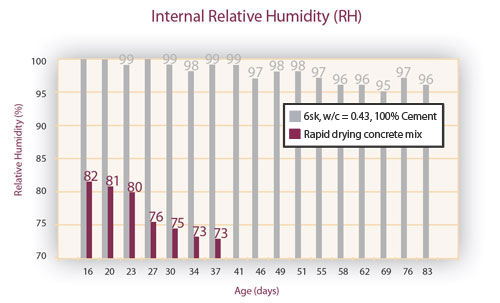 |
New rapid drying technology reached the target level of 80% relative humidity (RH) three times faster than 6 sacks (6sk) or 564 lbs of conventional concrete with w/c ratio of 0.43. Image provided by U.S. Concrete |
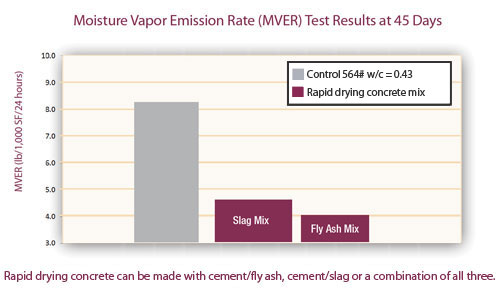 |
MVER tests for new rapid drying technology mixes meet flooring manufacturers requirements and show lower rates than for the control mix. Image provided by U.S. Concrete |
Rewetting
Unlike conventional concrete mixtures whose drying clock has to be restarted after being rained on or re-wetted, rapid drying concrete is not seriously affected by re-wetting. The drying of rapid drying concrete actually accelerates after being rained on compared with conventional concrete.
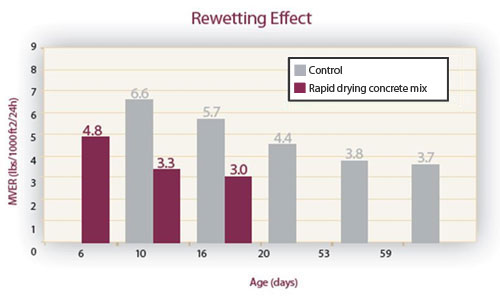 |
Side by side new rapid drying technology and conventional concrete were dried to an MVER of 3 lbs/1000 ft 2/24 hrs and “ponded” with a quarter inch of water for 24 hours. After soaking, the new concrete reached previous MVER levels in 16 days. Image provided by U.S. Concrete |
Curling
Because the new technology concrete relies on an internal drying mechanism rather than on surface evaporation to reduce internal moisture, the slab exhibits practically no curl or warping. Tests have demonstrated that the new mixture stabilizes shortly after construction whereas the degree of curl in conventional mixture continued to increase for months.
Reduced curling is a tremendous cost and time saving benefit for any tolerance critical situation.
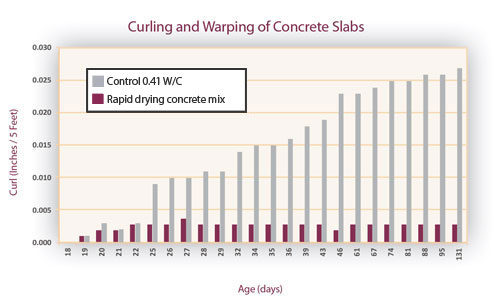 |
Curl specimens of the new rapid drying concrete and conventional concrete (w/c= 0.41) were tested with one end anchored after being cover cured for seven days. Image provided by U.S. Concrete |
Cost effective
The advantage of being able to design away slab moisture problems from the start of the project can translate into even greater cost savings when project delays are avoided and there is no need to disrupt other trades or activity to implement a late stage topical solution.
Other potential cost savings with the new rapid-drying concrete mixture include:
- Costs associated with addressing sick building syndrome and air quality issues within the building.
- Remediation costs for mold and mildew damage;
- Corrections to failed flooring.
- Investigations and testing required to resolve disputes.
- Construction delays and cost overruns caused by unplanned extended drying times.
- Costly business interruptions if flooring has to be treated, repaired or replaced.
- Liabilities associated with flooring failures and occupant illnesses.









